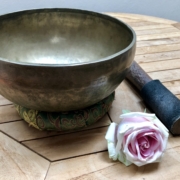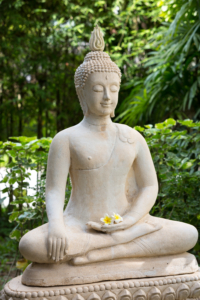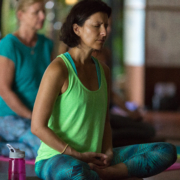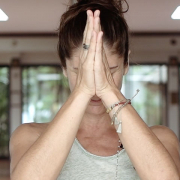 https://samahitaretreat.com/wp-content/uploads/2023/11/IMG_1290-2-scaled.jpg
1920
2560
Kirsten Mia
http://samahitaretreat.com/wp-content/uploads/2024/01/samahita-logo-v2.svg
Kirsten Mia2023-11-21 21:09:402023-11-21 21:09:40Music makes the world go round!
https://samahitaretreat.com/wp-content/uploads/2023/11/IMG_1290-2-scaled.jpg
1920
2560
Kirsten Mia
http://samahitaretreat.com/wp-content/uploads/2024/01/samahita-logo-v2.svg
Kirsten Mia2023-11-21 21:09:402023-11-21 21:09:40Music makes the world go round!The Buddha, the Dharma, the Sangha
Taking refuge in the Three Jewels: Embracing the world in all its complexities…
Life can be hard at times. We can feel overwhelmed, sad, fed-up, worried or confused, wanting to sometimes just run away or, like an ostrich, bury one’s head in the sand. Neither of these things will provide us with any meaningful or long-term solutions to our dismay or suffering, so what can we do instead? In today’s blog, we’ll unpack the framework of Buddhist philosophy. Throughout the ages, humans have sought to understand the meaning of life, a way out of pain and suffering (dukkha). Upon reaching enlightenment, Siddhartha Gautama (The Buddha – meaning “the awakened one”) shared his first sermon in India, and spoke about the 4 Noble Truths, which form the basis of his teaching from then on. The philosophy of Buddhism was born, to see things as they are, not the way we wish them to be, a way out of suffering…
The 3 Jewels – The Buddha, the Dharma, the Sangha
Taking refuge in the Three Jewels of Buddhism: the Buddha, the Dharma, the Sangha is one of the first steps in following the Buddhist teachings, a way to formalize one’s commitment and faith. Taking refuge doesn’t however mean retreating or escaping from life and its realities, rather, embracing life and all its complexities. The essence of Buddhism is about liberating the mind, freeing oneself from our human conditioning and to realize our true nature.
“Remember that awakening, freedom from suffering, salvation, if you will, liberation, omniscience, Buddhahood, all come from your own understanding, your insight into your own reality. It cannot come just from the blessing of another, from some magical empowerment, from some sort of secret gimmick, or from membership in a group.” (Robert Thurman – Buddhist and professor at Columbia University)
Buddhism has spread all over the world, and over the course of its development, different schools of thought and ritual emerged to become the branches known today as Mahayana and Theravada, and there are subsects to these as well. (such as Vajrayana, Zen, Tibetan, Nichiren) Without going into too much detail here, the philosophy and doctrinal foundation is the same with a slight difference of interpretation. The foundations for all Buddhists, are based on the key principles; The 4 Noble Truths, the Noble 8 Fold Path, the 5 Precepts, and the 3 Jewels – The Buddha, the Dharma, the Sangha.
I take refuge in the Buddha – Zen teacher Robert Aitken said of the First Jewel…
“This refers, of course, to Shakyamuni, the Enlightened One, but it also has a far broader meaning. It includes mythological personages who preceded Shakyamuni and dozens of archetypal figures in the Buddhist pantheon. It includes all the great teachers of our lineage … but also everyone who has realized his or her nature — all the monks, nuns, and lay people in Buddhist history who have shaken the tree of life and death. In a deeper and yet more ordinary dimension, all of us are Buddha. We haven’t realized it yet, but that does not deny the fact.”
I take refuge in the Dharma – Robert Thurman said of the second Jewel…
“Dharma is our own reality that we seek to understand fully, to open to fully. Dharma, therefore, also consists of those methods and the teaching of those methods that are the arts and sciences which enable us to open ourselves. The practices that we do, which will open us, which follow those teachings, which implement them in our lives, in our practice, and in our performance, which deploy those arts: they are also Dharma.”
I take refuge in the Sangha – The late Chogyam Trungpa said of the third Jewel…
“The sangha is the community of people who have the perfect right to cut through your trips and feed you with their wisdom, as well as the perfect right to demonstrate their own neurosis and be seen through by you. The companionship within the sangha is a kind of clean friendship, without expectation, without demand, but at the same time, fulfilling.”
Below is a little more detail into the foundations of Buddhist philosophy. I encourage you to do your own further research, there’s so many interesting and wonderful things to learn!
The 4 Noble Truth’s
The logical process of seeing life, seeing things as they are.
- The truth of suffering (dukkha) – Life is suffering. (stress, discomfort, disease, dissatisfied)
- The truth of the cause of suffering (samudaya) – Desire, craving through the senses, wanting more for the Self (as opposed to the whole).
- The truth of the end of suffering (nirhodha) – Change our perception and reduce our attachment to desire, suffering will reduce.
- The truth of the path that frees us from suffering (magga) – The way to the ending of suffering, the middle way, the Noble 8 Fold path.
The 5 Precepts/Virtues (panca-sila)
The precepts are the guidelines with which to live a moral and ethical life.
- Abstain from killing – not senselessly killing other beings, concern for the welfare of others.
- Abstain from stealing – Taking only what has been given, developing a sense of fair play and generosity towards others.
- Abstain from sexual misconduct – Not misusing the senses, to lead a more simple and balanced life.
- Abstain from wrong speech – Speak truthfully and kindly, not to gossip or lie.
- Abstain from the use of intoxicating substances that cause inattention – Avoid intoxicants like alcohol, unnecessary drugs, even caffeine to allow the development of inner clarity needed to be mindful.
The Noble Eightfold path
To train the practitioner in 3 areas: wisdom, ethical conduct and mental discipline.
- Right understanding – Seeing everything in the world as it is, not as we wish it to be. Eliminate ignorance.
- Right intent – Commitment to the path. This must come from the heart, recognizing the equality of all life with compassion. There to help and support.
- Right speech – Awareness of the impact of our words, thoughtful communication.
- Right action – This encompasses the 5 precepts as well as safeguarding our Earth.
- Right livelihood – The work you do in the world must not harm anyone or anything or compromise any of the precepts.
- Right effort – Cultivate enthusiasm, a positive attitude in a balanced way. Focused action.
- Right mindfulness – Being aware of the moment, clear, undistracted, fully absorbed. This forms the basis of meditation.
- Right concentration – Once the mind is uncluttered, you can then turn it to focus on an object. Release from the control of past pains and future mind games takes us closer to freedom from suffering. Meditative absorption.
Buddhism is a rich and deep philosophy which welcomes all faiths and people. The philosophy and teachings are realistic and practical, allowing us to embrace our existence, train the monkey mind, provide insight into our reality, to change the way we act and respond. To live in fullness with empathy, compassion, complete embodiment of the human experience while touching the essence of our true nature, in the now.
References:
https://buddha101.com/p_jewels.htm
https://studybuddhism.com/en/essentials/what-is/what-is-the-sangha
https://en.wikipedia.org/wiki/Dharma
https://intellectuallyfit.com/buddhist-four-noble-truths-simplified/
https://buddho.org/buddhism-and-morality-the-five-precepts/
https://www.learnreligions.com/the-four-noble-truths-450095
https://www.learnreligions.com/brief-guide-to-major-schools-of-buddhism-449971
https://hwpi.harvard.edu/files/pluralism/files/the_dharma-the_teachings_of_the_buddha_1.pdf
https://www.learnreligions.com/taking-refuge-becoming-a-buddhist-450056
More from the Samahita Blog







